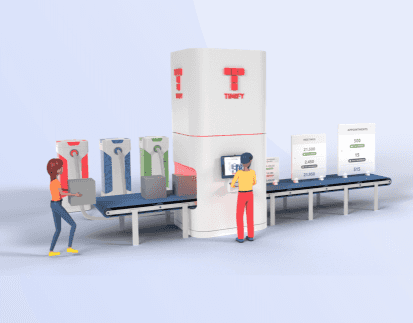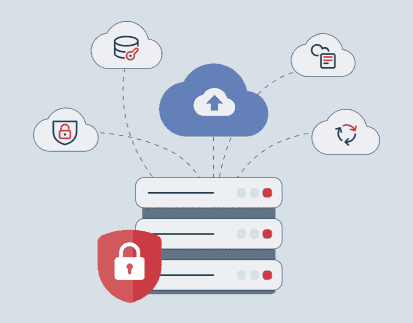

Gregory Batchelor
Gregory Batchelor is the Vice President of Growth Marketing at Platform.sh, a unified, enterprise-grade platform for building, running and scaling websites and applications.
Congratulations! You probably started with a single retail location and, through hard work and dedication, now have multiple locations or are ready to expand. These may be state-wide or nationwide and geographically scattered or clustered in urban areas. Whatever the pattern, there are similar challenges to meet when managing multiple premises.
While there may be some variations in the products or services you offer due to localized consumer trends, you’ll want to instill the same work ethic and standard of customer service across your stores.
With multiple business locations, one of the most important factors to consider is good communication, so you’re aware of issues as soon as they arise and can act to remedy them.
Many businesses are considering the question of how to find affiliates to boost their product awareness. It's important to explore all possible avenues for increasing sales and growing your customer base, and partnering with affiliates can be an effective strategy to achieve these goals.
If you’re running a retail business, it's also important to look at successful sales strategies, such as the Walmart sales strategy, and customize them according to your business.
Walmart's sales strategy focuses on providing a platform for sellers to increase their sales by optimizing conversion rates, enhancing customer experience, offering competitive prices, using tools to increase sales, and improving product details for SEO and ranking better in Walmart's search algorithm.
Managing multiple locations requires a deeper understanding of your retail operation, including inventory management, logistics, and customer service provision, among others.
So, what are the best management practices to follow when operating multiple locations so you can be sure they all operate efficiently and provide similar customer experiences?
Best practices for managing multiple business locations
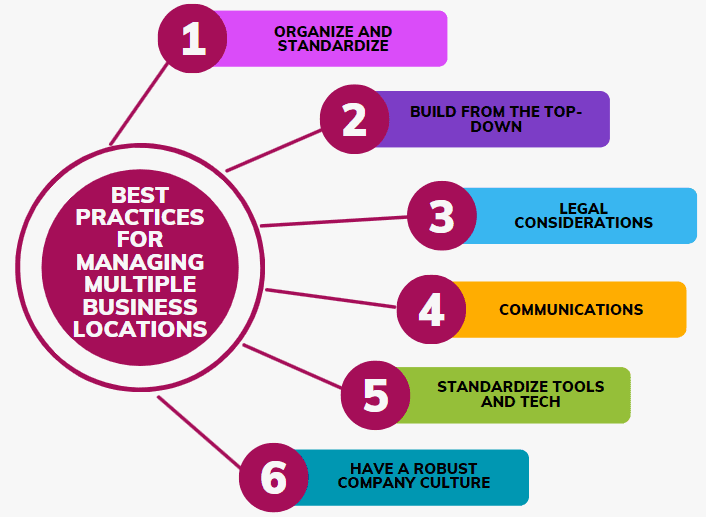
Everything starts with that first store. It may not be the biggest, and it may not produce the most revenue, but the successful operation of that location is what enabled you to open more stores. Because of this, it can often act as a blueprint as you expand, both in terms of what you did right and any mistakes you can learn from.
So, where to start…
1. Organize and standardize
Even running one store can be complicated. On the upside, when it comes to multiple locations, you can use what you’ve already learned to set out a plan for managing them successfully. Use the different processes and systems that made your first store do well to create a roadmap for managing others.
Of course, different stores may have some unique challenges. One that’s far away from your warehouses will need a slightly different approach when it comes to inventory management and reordering, for example.
But even with slight customization, the basic map should remain the same. By identifying the priority factors involved in running your outlets, you can organize, standardize, and make sure the same approach is implemented in each new store.
These factors might include:
- Inventory management and logistics.
- Customer service provision. As your business grows, you may decide to ‘centralize’ this with a call center, either physical or virtual.
- Human resources and employee management.
- Community participation and/or CSR (corporate social responsibility).
- Finance and accounting. Will each store be independent or will things such as payroll be handled from a central location or head office?
- Staff training. Creating a ‘master’ manual for training new staff ensures all new team members are trained to the same standard.
- Advertising. Level and type of advertising may vary from store to store (or area to area), but you should have common policy foundations when it comes to things such as Google Performance Max campaigns, for example.
2. Build from the top-down
While you eventually want all your staff to be singing from the same song sheet, you first need to identify potential leaders. These may come from your existing staff or be new recruits. For instance, you might decide to promote employees that have leadership potential.
Having a strong and efficient management team is crucial when it comes to managing multiple business locations, as you can trust them to implement the policies you used in your original premises across your new stores as well.
But it goes beyond just store management; you need to build a core team that shares your vision and values. That could include leaders in finance and accounting, logistics, warehousing, and so on.
You may also want to extend relocation packages to some of your best staff, who can help by passing on their experience and knowledge to new teams. These packages should be dependent on how far you want them to relocate. If you’re asking them to move a long way from their homes and your original store, you may have to offer attractive incentives that make it worth their time.
3. Legal considerations
If you’re running or planning to run multiple locations, you need to take local laws and regulations into consideration. If your other locations are in the same state, the same rules will apply to areas such as data protection and compliance. However, if you’re expanding into other states, you need to investigate if there are different legal and regulatory requirements.
This goes beyond operational requirements; it could also include something as simple as your business name and/or logo being in use in that state already. While you may be able to do some basic research yourself (a simple Google search can identify businesses using your name, for example), at some point, it would be advisable to get a lawyer on board.
Your lawyer can check any intellectual property issues that may arise, and ensure your business is structured properly and meets federal laws when it comes to multiple business locations. There will also be common laws you need to follow, so keep in mind the SOC 2 compliance checklist, for instance. You’ll also need to check whether there are any different employment laws that apply, as well as what your insurance needs will be—both in terms of your business as a whole and your employees.
4. Communications
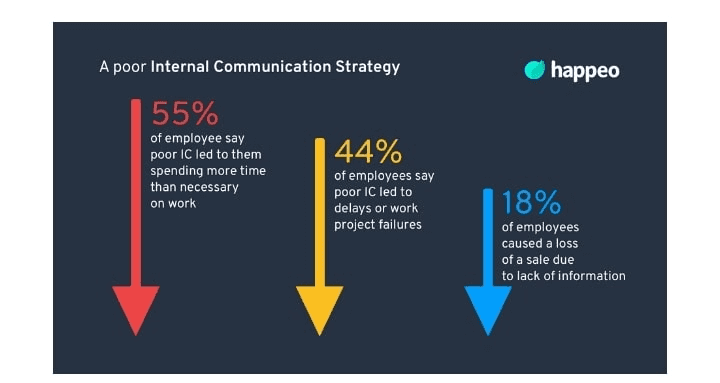
When running multiple stores, you need a robust communications policy that ties all your locations together. While managers may have a high degree of autonomy when it comes to day-to-day decisions, there’ll be some things you want to oversee yourself. Although these discussions may take place via a simple phone call, as you grow, you might need to consider investing in a company-wide communications platform.
Beyond managers, you want a way of communicating with your entire workforce. An intranet can be an efficient way of reaching all your employees and notifying them of any changes made to policies or operational models. However, it may be best to consider having multiple channels, including email and some type of instant messenger system too.
If you have multiple business locations, be sure to hold regular meetings. These may be weekly (or even more frequently) and offer a great opportunity for managers and other key personnel to get together. They should ideally take place via video meetings or conference calls and as participant availability becomes more complex, using software with a shared calendar and meeting booking functionality will save a lot of time long term.
5. Standardize tools and tech
There’s little point in different stores using different tools and tech. You want company-wide standardization so everything ties together and reporting on the company’s performance is centralized.
The ideal solution is to use cloud-based apps and software so your tools and teaching are accessible from every location. For example, you might want to look at solutions that allow you to manage multiple business locations from one platform.
Your tech needs will very much depend on the type of business you operate, but tools to consider investing in include:
- Inventory management software
- Accounting apps/software
- Point of sale (POS) systems
- Video conferencing platforms
- HR (including payroll) systems
- Payment solutions for customers
- Project management and collaboration software
- CRM (customer relationship management) systems
- Call center solutions (if needed)
- File storage and file transfer systems
- Digital experience software (you may want to look at a list of Acquia competitors before settling on one).
- Appointment scheduling software (for customer appointments, internal meetings and resource management)
By using the right tools and tech and standardizing their use across your business locations, you can streamline processes and workflows, such as optimizing staff scheduling and making centralized reporting easier.
It goes without saying that you’ll need to ensure all relevant staff are trained on how to use these tools (either via in-person training or online webinars) and that the needs of your remote/hybrid staff are also met.
6. Have a robust company culture
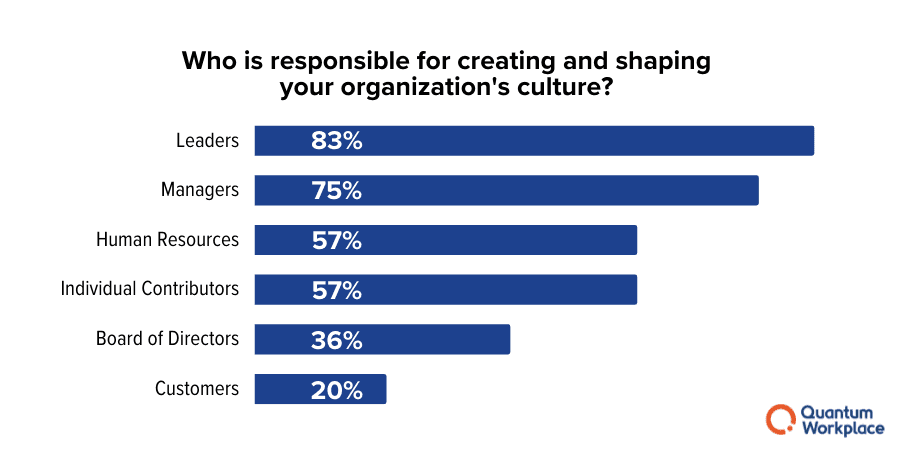
It doesn’t matter whether your stores (and staff) are in Boston or San Diego; you want your employees to know and adhere to your company culture. You want every single team member to be on board with this, as well as your stated vision, values, and mission. Much of this can be attained via strong communications and, for larger companies, an active intranet.
Depending on the size of your business, physical get-togethers may be impractical. However, you could organize these on a regional or even state basis. Think about different team-building activities you can hold too, both in-person and online. You want employees to not only feel connected to your business but invested in its success.
You may want to consider some gamification, with added incentives, prizes, or bonuses. Pitch different stores or other areas against each other in terms of factors such as revenue and CSAT (customer satisfaction) scores. Just be sure to keep any competition healthy and fun, as you want staff to think of your business as one large extended family.
The takeaway

It’s definitely a challenge to manage multiple business premises—but a rewarding one. There are many things to consider when operating in diverse locations that can be common to all or unique to one. You also need to think about things such as security operations at each store to combat both physical and cybersecurity threats.
If you’re already operating multiple business locations, then you should already have implemented most - if not all - of the points on this list. If you’re planning to expand the number of stores you operate, then this article can help you create an expansion roadmap and ensure you adopt the best practices possible.

About the author
Gregory Batchelor
Gregory Batchelor is the Vice President of Growth Marketing at Platform.sh, a unified, enterprise-grade platform for building, running and scaling websites and applications. With over 20 years of experience in the tech sector, including time at companies including Oracle, Cisco and NTT, he has developed a reputation as a marketing and business operations leader. In his spare time, Gregory enjoys spending time with his family, traveling, and playing lots of golf.
Related articles

